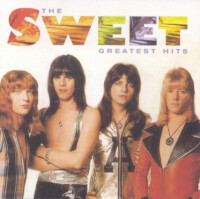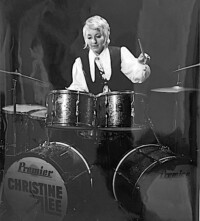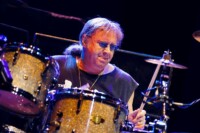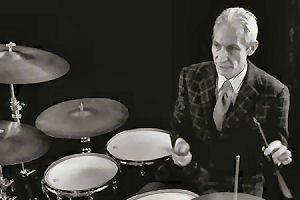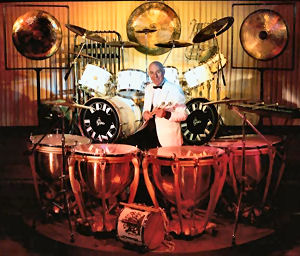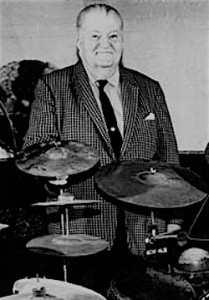 Quite a few of the drummers I’ve been writing about in G&S have one thing in common – Roy C Knapp. He isn’t famous for playing with anyone famous – unless of course you know the names of the ‘proper’ orchestras in which he played drums and tuned percussion in any of the 17 theatres once situated inside what is arguably called ‘the Loop’ formed by the elevated railway which ran around Chicago.
Quite a few of the drummers I’ve been writing about in G&S have one thing in common – Roy C Knapp. He isn’t famous for playing with anyone famous – unless of course you know the names of the ‘proper’ orchestras in which he played drums and tuned percussion in any of the 17 theatres once situated inside what is arguably called ‘the Loop’ formed by the elevated railway which ran around Chicago.
No, Roy C. didn’t play with any of the great jazz artists like the Dorsey Brothers, Glen Miller, Harry James, Stan Kenton, Billy May, Artie Shaw, Lionel Hampton, Count Basie, Duke Ellington et al. he did better than that. He taught the drummers who propelled many of the ground-breaking bands of the twenties, thirties, forties and fifties to fame and fortune. And as time went by he was also responsible not only for the techniques, but also for the approach to the business of the new generation of drummers like Earl Palmer and Hal Blaine who made their mark by straightening-out the very rhythm of jazz and forging their way into Rock ‘n’ Roll music.
But let’s begin at the beginning. Roy C. Knapp was born in Waterlooville, Louisiana (or was it Iowa? both states have a town which wasn’t named for the Duke of Wellington’s battle-ground) on October 26th, 1891. Here he eventually had lessons on mandolin, violin, piano, and various percussion instruments. He moved to Chicago in 1921 after working in Duluth, Minnesota and New York where he played in theatres and his specialties were drums and xylophone. He also played percussion in the Minneapolis Symphony Orchestra. Living in Chicago it was inevitably he was going to be a Ludwig or a Slingerland endorser and in the event, he was both. The Percussive Arts Society has one of his traps sets in its museum most of which is made by WFL which comprises: 24 x 12” bass drum, 14 x 6” wood shell snare drum with tube lugs, four Chinese toms with double -headed tacked on heads from 6 x 3” up to 12 x 9”, copper timbales and a snow-shoe pedal. (His bass drum pedal was evidently unique in that he could strike the drum and the cymbal attached to it at the same time.)
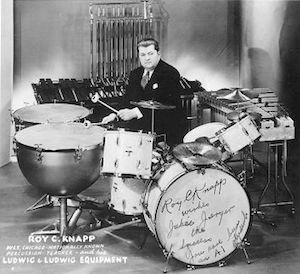 On the side to his gigs he taught drums and percussion from his home in Elmwood Park (and invariably simply on a practise pad) for which he charged $25 dollars for 10 lessons. His ambition was to have a proper music school and in 1938, while still heavily involved with professional playing, he realised that ambition. The ‘Roy C. Knapp School of Percussion’ on the 6th floor of The Kimball Hall building on South Wabash Avenue soon became the most-respected music school in the USA with six teaching staff overseen by Roy himself known as ‘The Dean of Drums’. His pupils say he didn’t work from any books and still hand-wrote all the drum music for each student in a yellow legal pad in pencil as they progressed through the lesson.
On the side to his gigs he taught drums and percussion from his home in Elmwood Park (and invariably simply on a practise pad) for which he charged $25 dollars for 10 lessons. His ambition was to have a proper music school and in 1938, while still heavily involved with professional playing, he realised that ambition. The ‘Roy C. Knapp School of Percussion’ on the 6th floor of The Kimball Hall building on South Wabash Avenue soon became the most-respected music school in the USA with six teaching staff overseen by Roy himself known as ‘The Dean of Drums’. His pupils say he didn’t work from any books and still hand-wrote all the drum music for each student in a yellow legal pad in pencil as they progressed through the lesson.
As a drummer and percussionist himself he was anxious to teach those instruments to the highest level but wasn’t able to. The other colleges blocked the way and it wasn’t until Harry S. Truman became president in 1945 that he was able to realise that ambition. President Truman pressurised these colleges putting forward the claim that not offering a Bachelor of Music Percussion degree course was discriminatory and by 1946 Roy C. Knapp was offering one in Chicago. His very first students where George Wettling and Davey Tough but, in the fullness of time, his student roster included absolute household names like Gene Krupa, Buddy Rich, Baby Dodds, Sid Catlett, Louie Bellson, Freddie Below, Bobby Christian, Buddy Harman, Shelly Manne, Ed Shaughnessy, Hal Blaine (whom he only knew as Harold Belsky) and even Mel Tormé. (I have no idea who taught Frank Sinatra to look like he could play the drums for ‘The Man With The Golden Arm’ but there’s a very good chance it was Roy C. Knapp esq.)
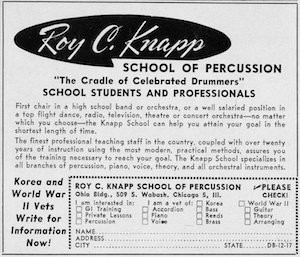 For the record, Gene Krupa was Roy’s absolute favourite student although he says he learned more from all his students than vice versa! However Gene Krupa, who he said, “was the greatest talent he had to work with” actually came to him to study timpani. Roy managed to switch him to drums which he took to straightaway and immediately grasped his counting system. According to Roy, we drummers would never have had any respect and would forever have been the butt of musicians’ jokes had it not been for Gene Krupa.
For the record, Gene Krupa was Roy’s absolute favourite student although he says he learned more from all his students than vice versa! However Gene Krupa, who he said, “was the greatest talent he had to work with” actually came to him to study timpani. Roy managed to switch him to drums which he took to straightaway and immediately grasped his counting system. According to Roy, we drummers would never have had any respect and would forever have been the butt of musicians’ jokes had it not been for Gene Krupa.
Lessons at The Roy C. Knapp School of Percussion besides the obvious drum rudiments included harmony, composition, music appreciation, how to apply those rudiments and believe it or not, as I said, you’d actually be taught how to count! To reinforce these lessons his ex-pupils, who were now successfully playing in really big big bands would drop by with their musician pals when they were in town to show everybody how it was done!
 He’d been playing in an orchestra for a radio station called WLS from 1928 until 1950 but In 1960 he gave-up playing and concentrated on teaching and running his own drum shop. Six years later Maurie Lishon offered him the opportunity to teach at Frank’s Drum Shop which was also on Wabash and where he stayed for the remainder of his life.
He’d been playing in an orchestra for a radio station called WLS from 1928 until 1950 but In 1960 he gave-up playing and concentrated on teaching and running his own drum shop. Six years later Maurie Lishon offered him the opportunity to teach at Frank’s Drum Shop which was also on Wabash and where he stayed for the remainder of his life.
I have searched far and wide to discover what the first initial of his middle name stood for and the closest I can get by researching his sons – both of whom were drummers – is Cecil.
If I’m right then, Roy Cecil Knapp died June 16th, 1979 and left a legacy of nurturing talent which from a drumming point of view cannot possibly be equalled. There was a particularly apposite slogan at the top of his headed notepaper which he also used on his adverts which stated his school was: “The cradle of professional drummers”.
Bob Henrit
December 2016

